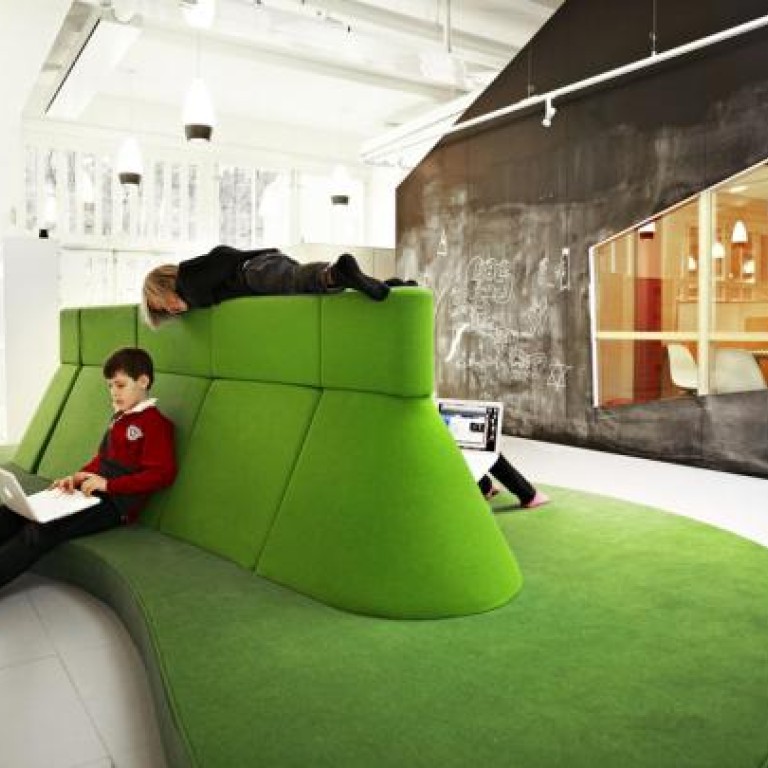
Danes the highlight of Business of Design Week
Annual Hong Kong event to host some of the leading lights of Denmark, a front runner in humanist designs based on the needs of people
When Copenhagen-based architect Rosan Bosch was commissioned to design the interiors of a school in Stockholm, she introduced a giant iceberg with a cinema, a room for relaxation and recreation, and colourful custom-designed furnishings designed to inspire creativity and learning.
"The school library is so cool. The teenagers hang out there even when they are finished their school day," Bosch says. "Design ... is not a mere practice of doing something aesthetic. It is a tool for making a physical environment better."
Bosch will present this and other examples of her imaginative designs at the Hong Kong Business of Design Week (BODW) next week. This year's partnership with Denmark brings to Hong Kong some of the country's best-known designers.
"Bringing together some of the best minds on design and business has been key to BODW's success over the past 10 years," says William To, the Hong Kong Design Centre's project director, who is responsible for the event.
"This year's theme, Design for Society, reflects a growing awareness that design is key to every decision - business or social. Denmark has a very rich design culture and is at the forefront of social design so we hope to learn a lot from them."
Kigge Hvid, chief executive of non-profit organisation INDEX: Design to Improve Life, says the large Danish delegation at BODW offers the perfect opportunity to present the country's full scale of design traditions and styles, and commitment to creativity.
"Denmark is at the forefront of solving the welfare and environmental challenges that many countries face so we hope to be an inspiration and to work with other nations to solve these issues," Hvid says.
He played a key role in leading the Danish government's mandate to develop the humanist tenets of Danish design, and also sits on the international advisory board of the Hong Kong Design Centre.
"Denmark has a dual tradition of functional and large-scale societal design," says Hvid.
"We were late in becoming industrialised so we kept our craftsmen for much longer and there is a closer infusion between the two: craftsmen helped inform how to create industrial products.
"We also have a long and strong tradition of democracy, so we have developed a tradition of designing solutions based on the needs of people."
Hvid will present the opening address at BODW and the INDEX exhibition will be part of BODW's simultaneous Detour event, showing how 60 finalists for INDEX's award address challenges such as education, climate change and energy supply.
The award is widely recognised as the biggest design prize in the world (€500,000, or HK$5.02 million) and the most influential in inspiring life-improving design.
Danish designer Jens Martin Skibsted, co-founder of KiBiSi, one of Scandinavia's most influential cross-disciplinary design groups, is particularly interested in sustainable design. "Denmark comes from a history of scarcity so we naturally always think about saving energy and money," he says. "It is a given that products should last for a long time." At BODW he will present KiBiSi's design philosophy of moving beyond form and functionality. "We want the idea to lead design. Form and function should follow the idea."
Copenhagen-based Kontrapunkt brand and design-agency founder Bo Linnemann will present a Danish approach to design: the intriguing results of Kontrapunkt's personal research on creative typeface.
"How you reveal your brand through a typeface provides a huge advantage," says Linnemann. "It is obviously more complicated when working with dual language but we have developed a typeface that allows words to be read in a co-ordinated message."
For example, Kontrapunkt's Tokyo office created a refined typeface for Japanese luxury jewellery brand Tasaki, using a classic refined serif look with a soft brush in the 'K' to reflect the company's shift to a modern image. Again the issue of responsibility is integral to the creative process.
"It is so important that you tell the right story in an honest way," says Linnemann. "Be transparent and remember integrity in design is the designer's responsibility. Of course, the Danish model may not be directly exportable everywhere but our approach that emphasises the honesty and simplicity of the message behind a brand certainly is."
Other highlights at BODW include a high-profile forum featuring other prominent speakers from around the world.
This year's Hong Kong Design Centre Award Winner, Tokyo-based Klein Dytham Architecture's Mark Dytham, will present Daikanyama T-Site, an innovative retail complex that combines old and new technologies.
Meanwhile, Japan- and US-based Party "Creative Lab" co-founder and creative director Masashi Kawamura hopes his approach to design will help people understand that there are different ways of making things.
"Design processes often become a routine ... we're more interested in reinventing the process per project," he says. "We try to design the process itself before designing the product."
Kawamura (listed on Fast Company's "100 Most Creative People in Business" 2012) plans to present his mixture of storytelling and technology.
"The most exciting part of creativity is coming up with the initial idea or solution," Kawamura says. "We work for markets and companies in very different cultural contexts but instead of focusing on difference, we try to find common characteristics ... From there you can create content that works globally."
BODW has the potential to go beyond the sharing of creative ideas, says Danish Design Centre chief executive Nille Juul-Sorensen, who hopes to stimulate discussion about global challenges.
"Government and business need to change to make design more relevant, but the design community also needs to change. All parties need to get together and design for the real challenges ... We have been talking for too long; we need action."

